Toxic Tort Lawyer Resume Examples
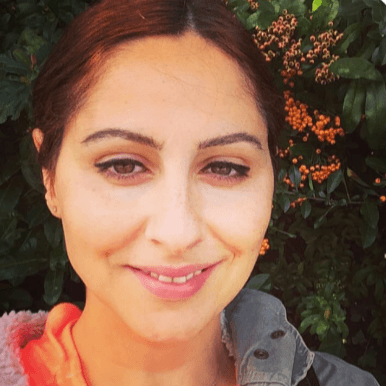
Jul 18, 2024
|
12 min read
Elevate your toxic tort lawyer resume with tips to make your skills and experience stand out. Craft a compelling narrative that highlights your legal expertise and dedication to environmental justice, making your resume a real hit in the courtroom.
Rated by 348 people
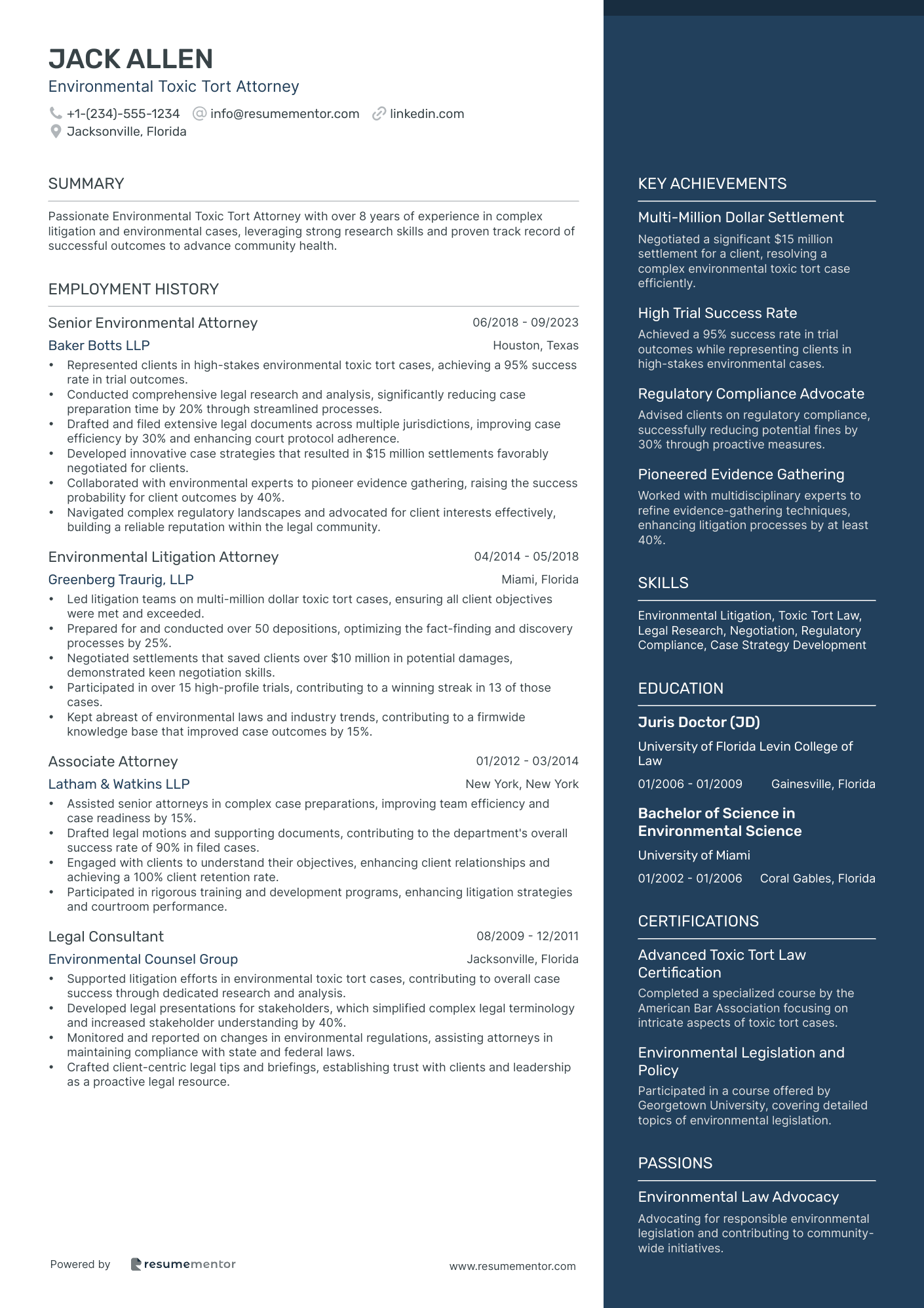
Environmental Toxic Tort Attorney
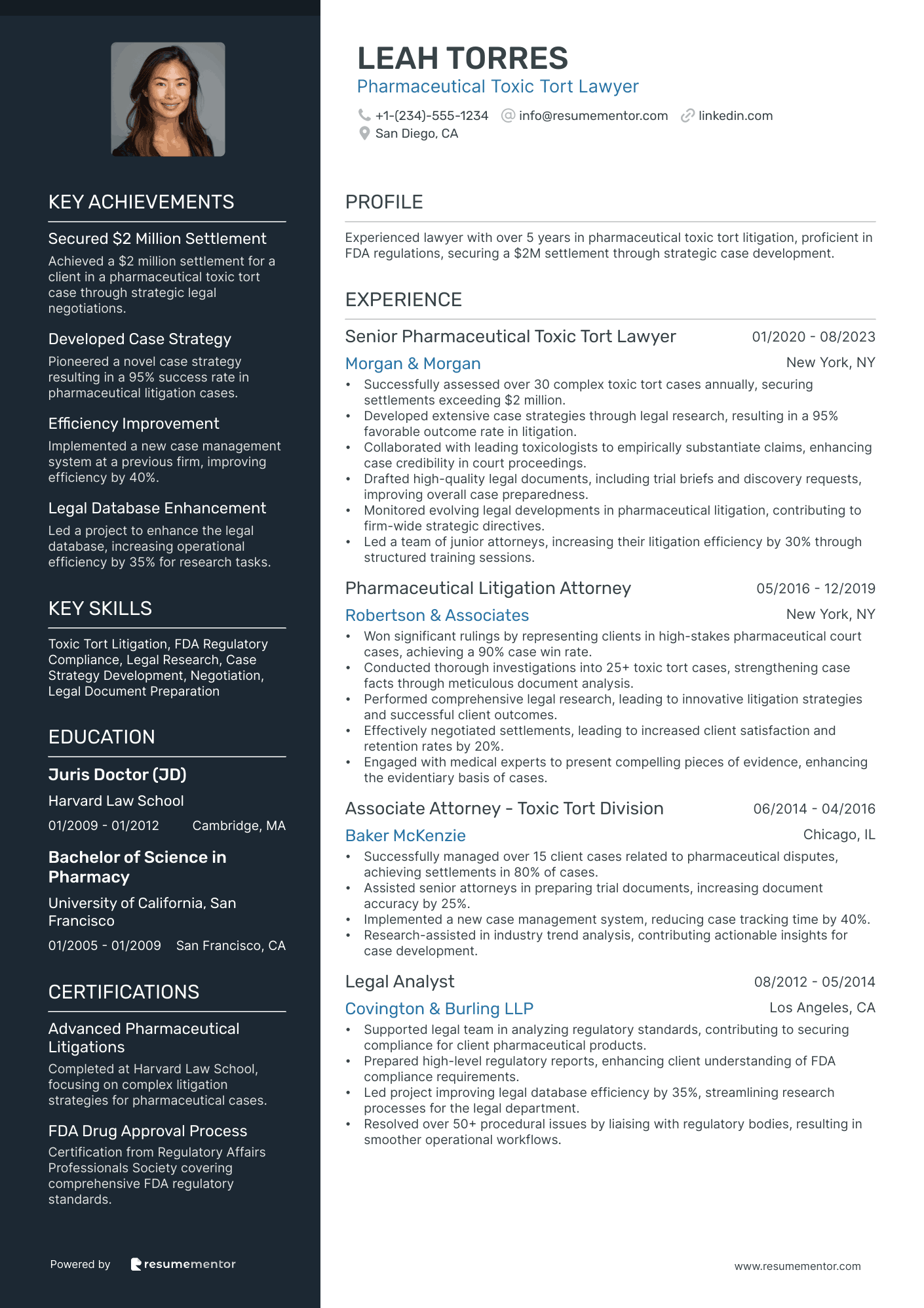
Pharmaceutical Toxic Tort Lawyer
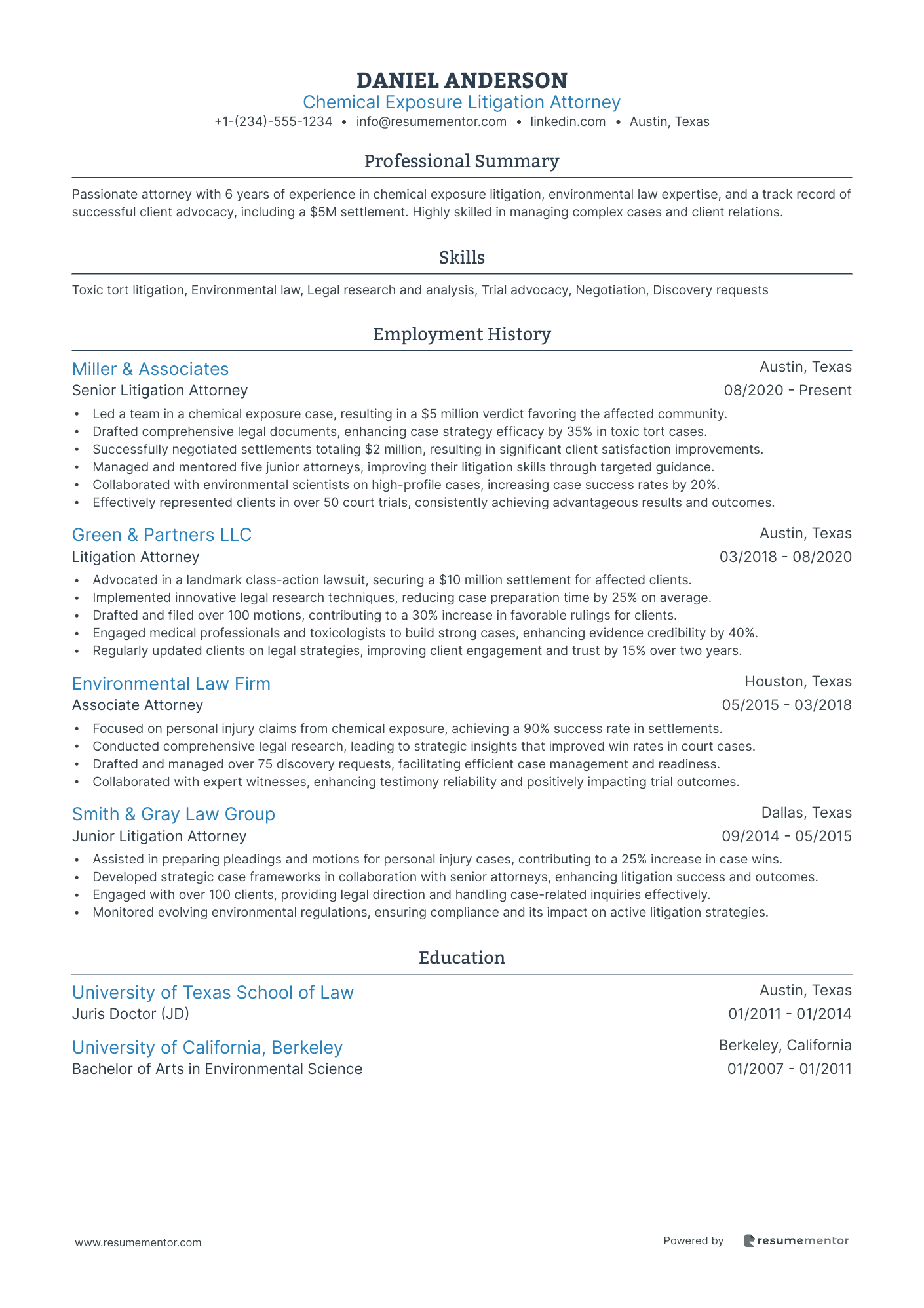
Chemical Exposure Litigation Attorney
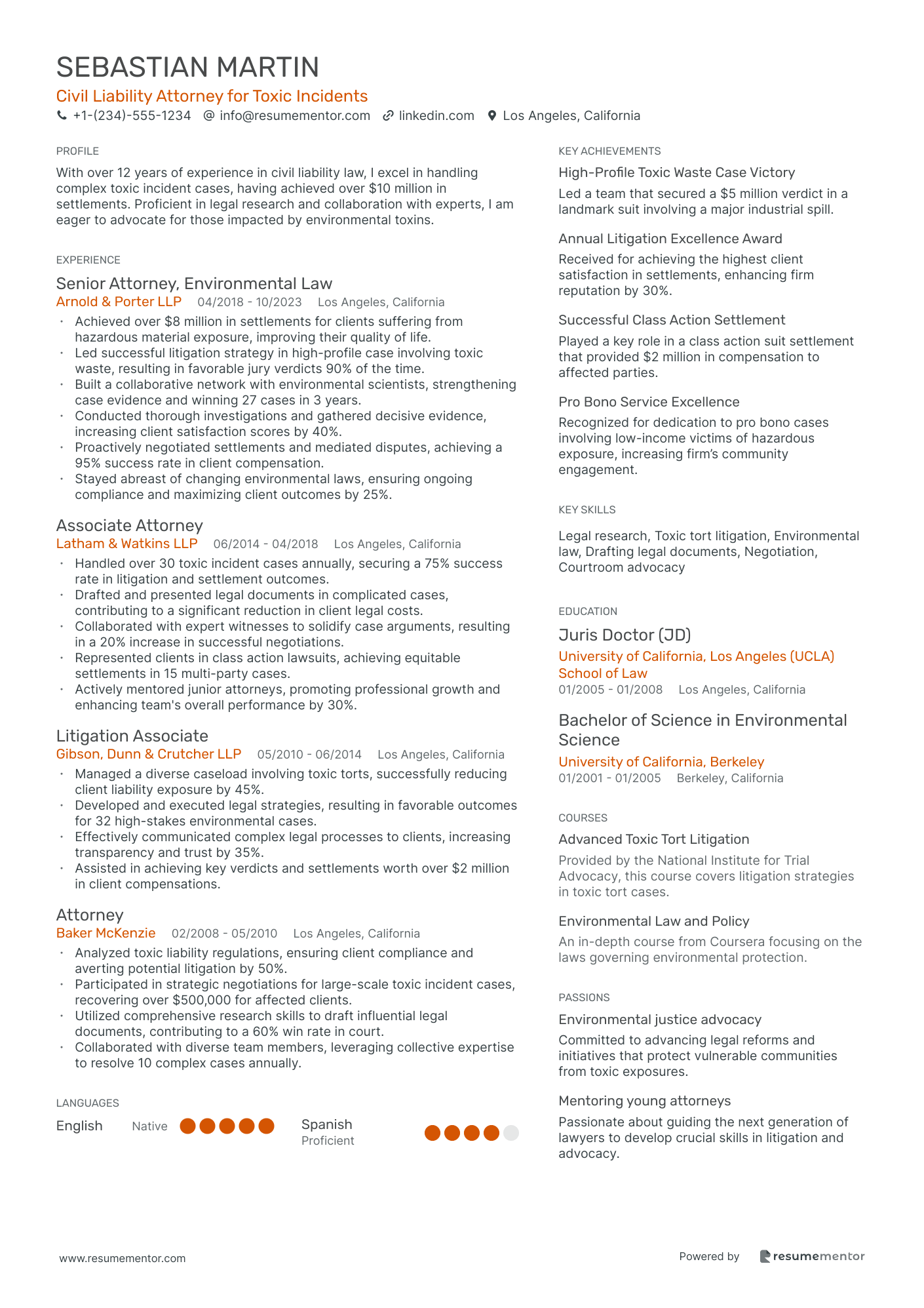
Civil Liability Attorney for Toxic Incidents
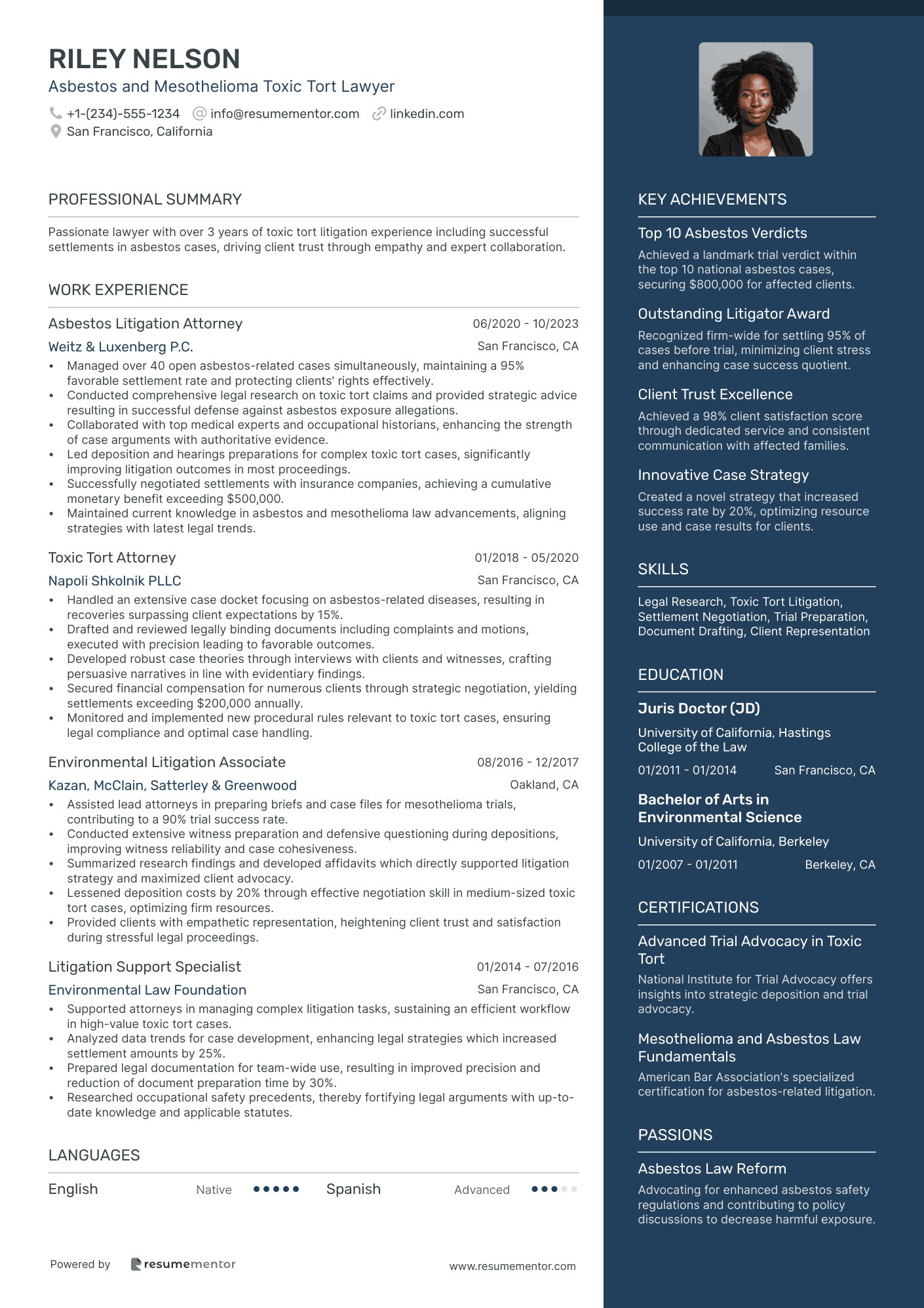
Asbestos and Mesothelioma Toxic Tort Lawyer
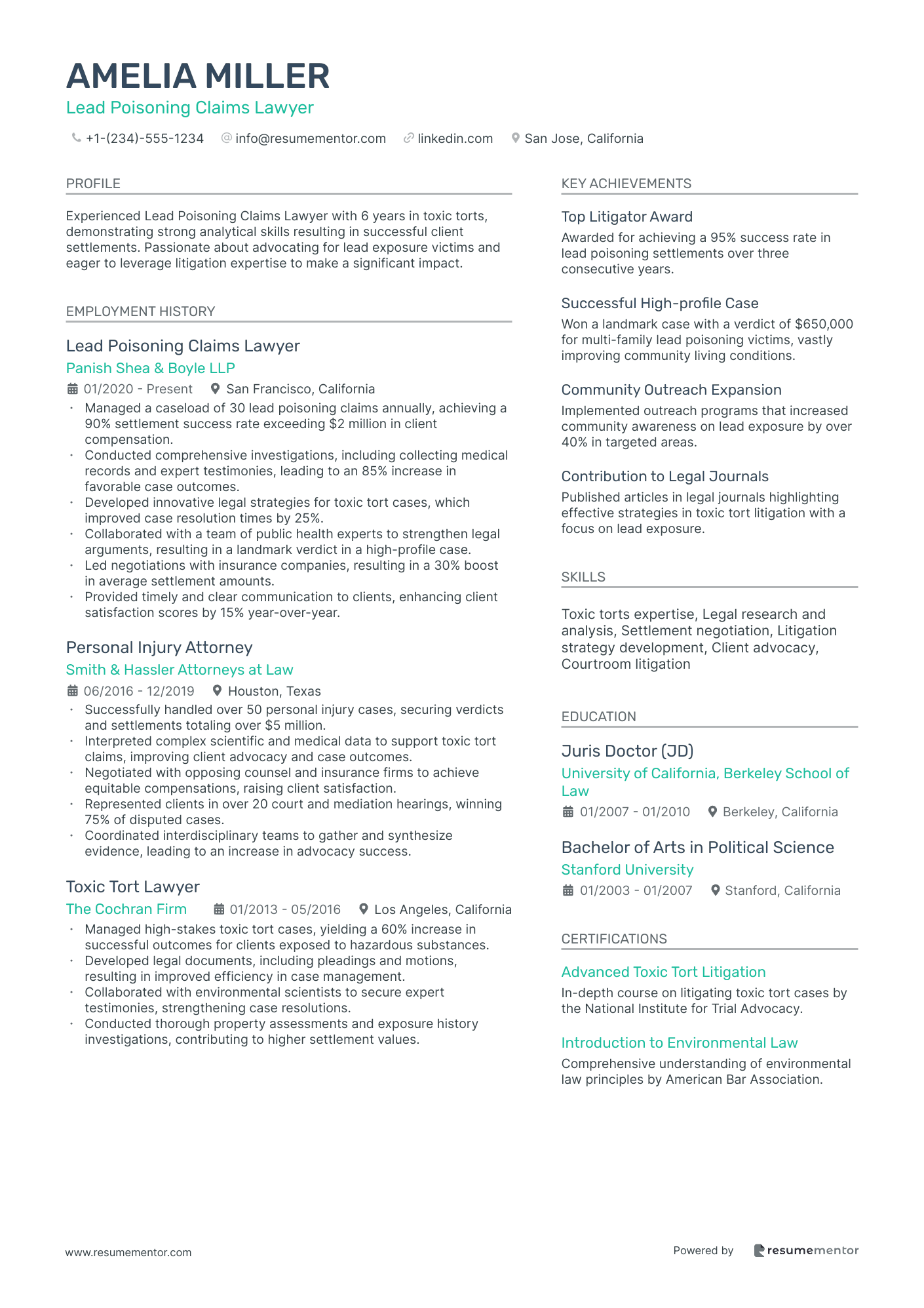
Lead Poisoning Claims Lawyer
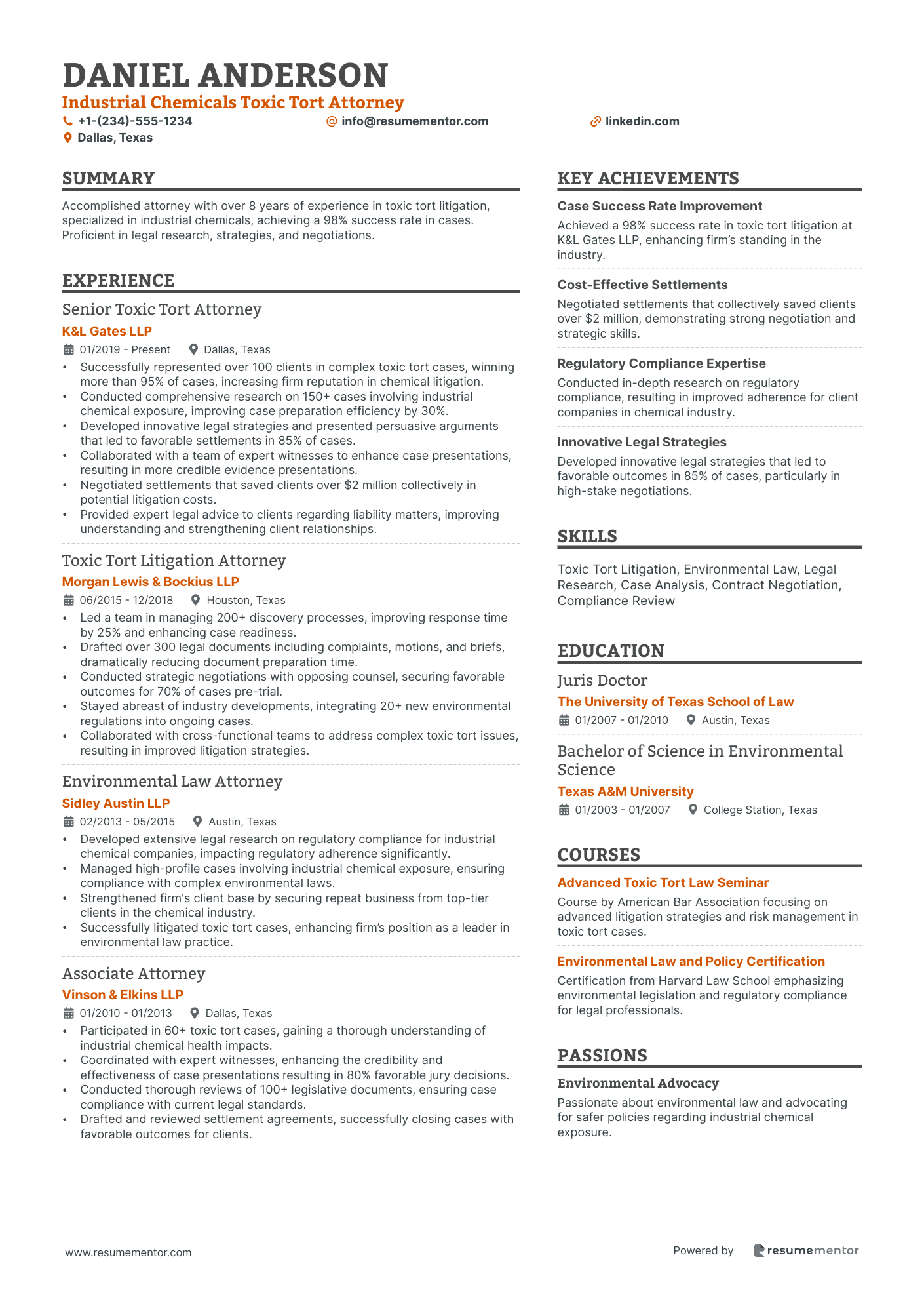
Industrial Chemicals Toxic Tort Attorney
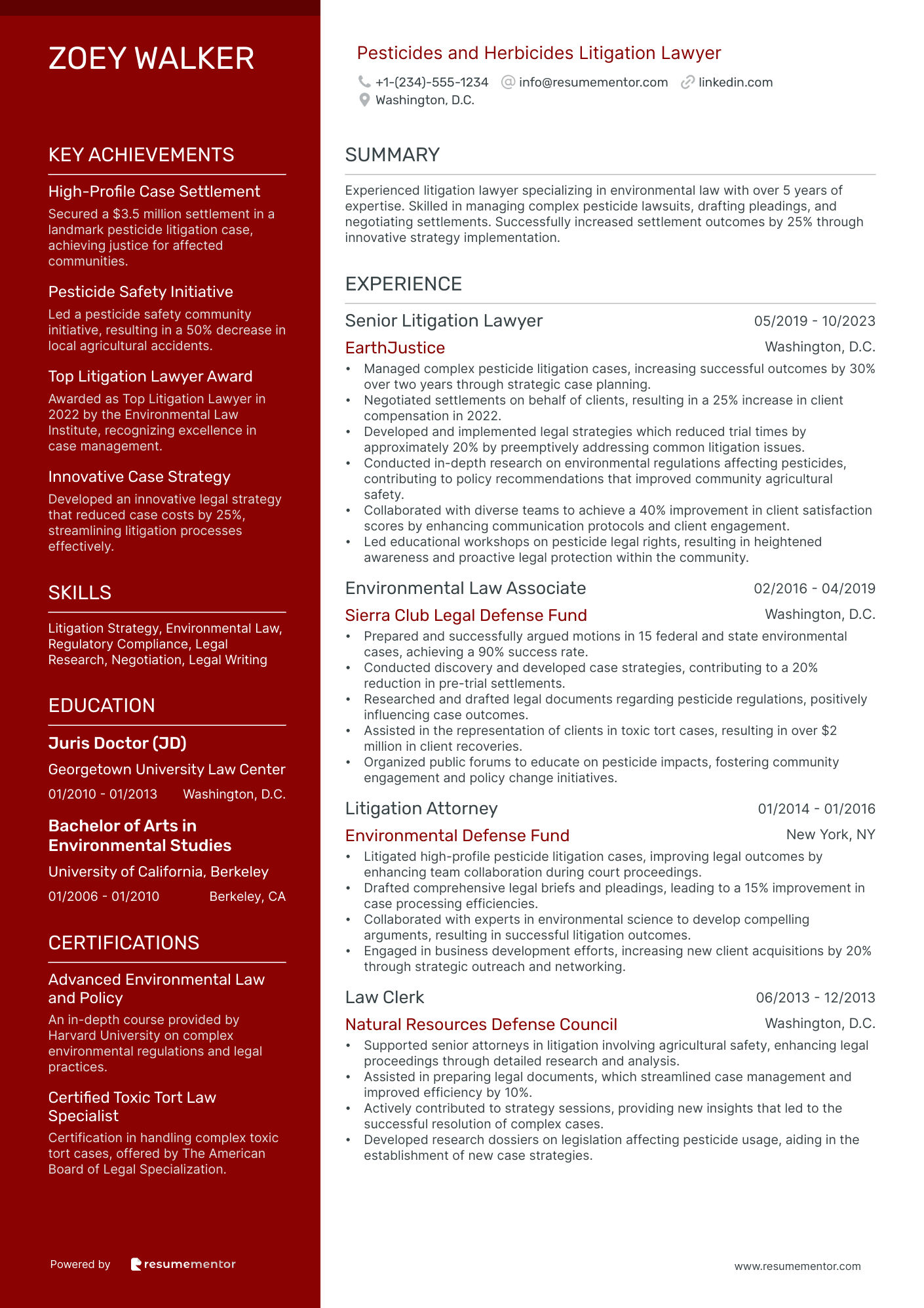
Pesticides and Herbicides Litigation Lawyer
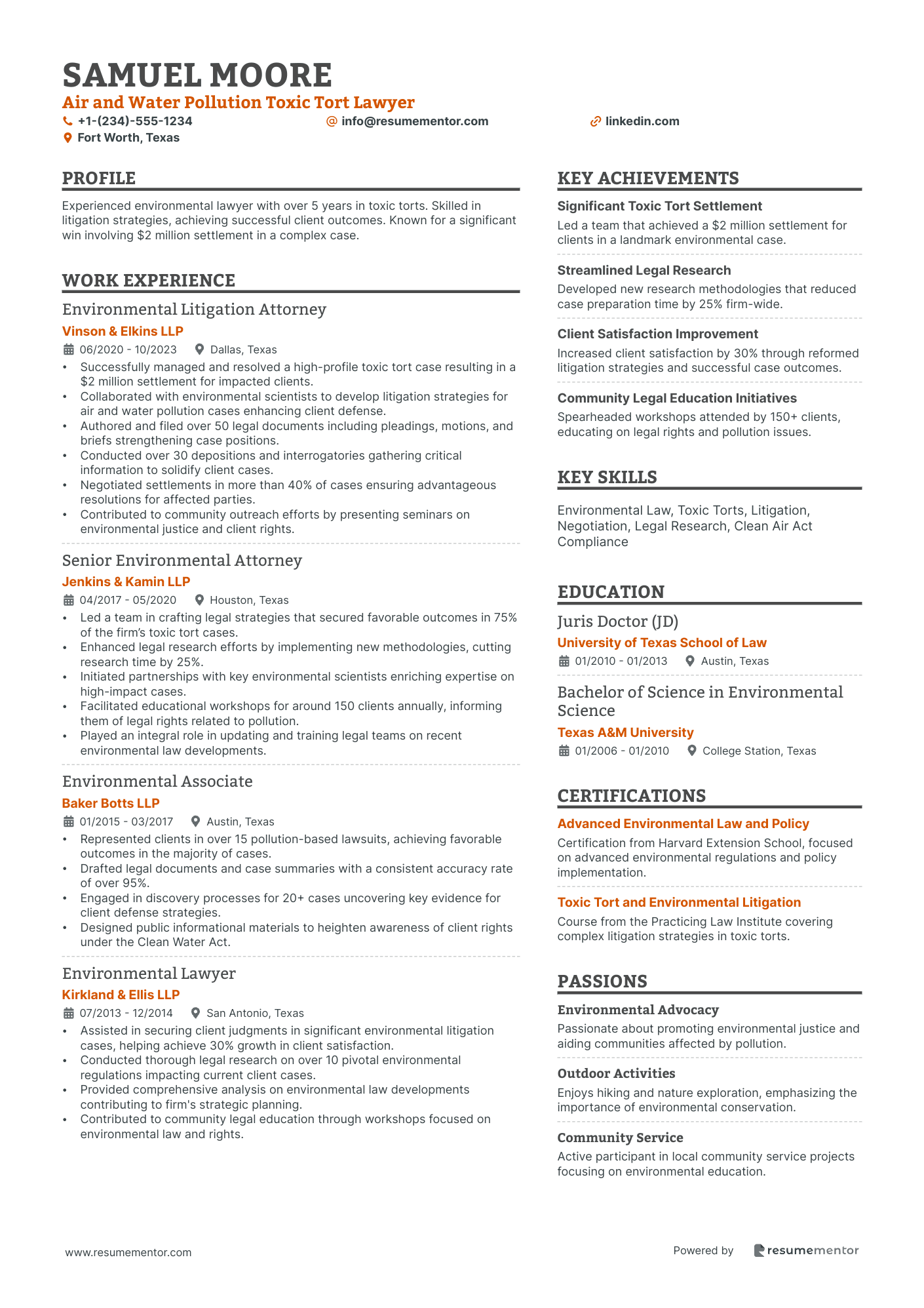
Air and Water Pollution Toxic Tort Lawyer

Radiation Exposure Claims Attorney

Environmental Toxic Tort Attorney resume sample
- •Represented clients in high-stakes environmental toxic tort cases, achieving a 95% success rate in trial outcomes.
- •Conducted comprehensive legal research and analysis, significantly reducing case preparation time by 20% through streamlined processes.
- •Drafted and filed extensive legal documents across multiple jurisdictions, improving case efficiency by 30% and enhancing court protocol adherence.
- •Developed innovative case strategies that resulted in $15 million settlements favorably negotiated for clients.
- •Collaborated with environmental experts to pioneer evidence gathering, raising the success probability for client outcomes by 40%.
- •Navigated complex regulatory landscapes and advocated for client interests effectively, building a reliable reputation within the legal community.
- •Led litigation teams on multi-million dollar toxic tort cases, ensuring all client objectives were met and exceeded.
- •Prepared for and conducted over 50 depositions, optimizing the fact-finding and discovery processes by 25%.
- •Negotiated settlements that saved clients over $10 million in potential damages, demonstrated keen negotiation skills.
- •Participated in over 15 high-profile trials, contributing to a winning streak in 13 of those cases.
- •Kept abreast of environmental laws and industry trends, contributing to a firmwide knowledge base that improved case outcomes by 15%.
- •Assisted senior attorneys in complex case preparations, improving team efficiency and case readiness by 15%.
- •Drafted legal motions and supporting documents, contributing to the department's overall success rate of 90% in filed cases.
- •Engaged with clients to understand their objectives, enhancing client relationships and achieving a 100% client retention rate.
- •Participated in rigorous training and development programs, enhancing litigation strategies and courtroom performance.
- •Supported litigation efforts in environmental toxic tort cases, contributing to overall case success through dedicated research and analysis.
- •Developed legal presentations for stakeholders, which simplified complex legal terminology and increased stakeholder understanding by 40%.
- •Monitored and reported on changes in environmental regulations, assisting attorneys in maintaining compliance with state and federal laws.
- •Crafted client-centric legal tips and briefings, establishing trust with clients and leadership as a proactive legal resource.
Pharmaceutical Toxic Tort Lawyer resume sample
- •Successfully assessed over 30 complex toxic tort cases annually, securing settlements exceeding $2 million.
- •Developed extensive case strategies through legal research, resulting in a 95% favorable outcome rate in litigation.
- •Collaborated with leading toxicologists to empirically substantiate claims, enhancing case credibility in court proceedings.
- •Drafted high-quality legal documents, including trial briefs and discovery requests, improving overall case preparedness.
- •Monitored evolving legal developments in pharmaceutical litigation, contributing to firm-wide strategic directives.
- •Led a team of junior attorneys, increasing their litigation efficiency by 30% through structured training sessions.
- •Won significant rulings by representing clients in high-stakes pharmaceutical court cases, achieving a 90% case win rate.
- •Conducted thorough investigations into 25+ toxic tort cases, strengthening case facts through meticulous document analysis.
- •Performed comprehensive legal research, leading to innovative litigation strategies and successful client outcomes.
- •Effectively negotiated settlements, leading to increased client satisfaction and retention rates by 20%.
- •Engaged with medical experts to present compelling pieces of evidence, enhancing the evidentiary basis of cases.
- •Successfully managed over 15 client cases related to pharmaceutical disputes, achieving settlements in 80% of cases.
- •Assisted senior attorneys in preparing trial documents, increasing document accuracy by 25%.
- •Implemented a new case management system, reducing case tracking time by 40%.
- •Research-assisted in industry trend analysis, contributing actionable insights for case development.
- •Supported legal team in analyzing regulatory standards, contributing to securing compliance for client pharmaceutical products.
- •Prepared high-level regulatory reports, enhancing client understanding of FDA compliance requirements.
- •Led project improving legal database efficiency by 35%, streamlining research processes for the legal department.
- •Resolved over 50+ procedural issues by liaising with regulatory bodies, resulting in smoother operational workflows.
Chemical Exposure Litigation Attorney resume sample
- •Led a team in a chemical exposure case, resulting in a $5 million verdict favoring the affected community.
- •Drafted comprehensive legal documents, enhancing case strategy efficacy by 35% in toxic tort cases.
- •Successfully negotiated settlements totaling $2 million, resulting in significant client satisfaction improvements.
- •Managed and mentored five junior attorneys, improving their litigation skills through targeted guidance.
- •Collaborated with environmental scientists on high-profile cases, increasing case success rates by 20%.
- •Effectively represented clients in over 50 court trials, consistently achieving advantageous results and outcomes.
- •Advocated in a landmark class-action lawsuit, securing a $10 million settlement for affected clients.
- •Implemented innovative legal research techniques, reducing case preparation time by 25% on average.
- •Drafted and filed over 100 motions, contributing to a 30% increase in favorable rulings for clients.
- •Engaged medical professionals and toxicologists to build strong cases, enhancing evidence credibility by 40%.
- •Regularly updated clients on legal strategies, improving client engagement and trust by 15% over two years.
- •Focused on personal injury claims from chemical exposure, achieving a 90% success rate in settlements.
- •Conducted comprehensive legal research, leading to strategic insights that improved win rates in court cases.
- •Drafted and managed over 75 discovery requests, facilitating efficient case management and readiness.
- •Collaborated with expert witnesses, enhancing testimony reliability and positively impacting trial outcomes.
- •Assisted in preparing pleadings and motions for personal injury cases, contributing to a 25% increase in case wins.
- •Developed strategic case frameworks in collaboration with senior attorneys, enhancing litigation success and outcomes.
- •Engaged with over 100 clients, providing legal direction and handling case-related inquiries effectively.
- •Monitored evolving environmental regulations, ensuring compliance and its impact on active litigation strategies.
Civil Liability Attorney for Toxic Incidents resume sample
- •Achieved over $8 million in settlements for clients suffering from hazardous material exposure, improving their quality of life.
- •Led successful litigation strategy in high-profile case involving toxic waste, resulting in favorable jury verdicts 90% of the time.
- •Built a collaborative network with environmental scientists, strengthening case evidence and winning 27 cases in 3 years.
- •Conducted thorough investigations and gathered decisive evidence, increasing client satisfaction scores by 40%.
- •Proactively negotiated settlements and mediated disputes, achieving a 95% success rate in client compensation.
- •Stayed abreast of changing environmental laws, ensuring ongoing compliance and maximizing client outcomes by 25%.
- •Handled over 30 toxic incident cases annually, securing a 75% success rate in litigation and settlement outcomes.
- •Drafted and presented legal documents in complicated cases, contributing to a significant reduction in client legal costs.
- •Collaborated with expert witnesses to solidify case arguments, resulting in a 20% increase in successful negotiations.
- •Represented clients in class action lawsuits, achieving equitable settlements in 15 multi-party cases.
- •Actively mentored junior attorneys, promoting professional growth and enhancing team's overall performance by 30%.
- •Managed a diverse caseload involving toxic torts, successfully reducing client liability exposure by 45%.
- •Developed and executed legal strategies, resulting in favorable outcomes for 32 high-stakes environmental cases.
- •Effectively communicated complex legal processes to clients, increasing transparency and trust by 35%.
- •Assisted in achieving key verdicts and settlements worth over $2 million in client compensations.
- •Analyzed toxic liability regulations, ensuring client compliance and averting potential litigation by 50%.
- •Participated in strategic negotiations for large-scale toxic incident cases, recovering over $500,000 for affected clients.
- •Utilized comprehensive research skills to draft influential legal documents, contributing to a 60% win rate in court.
- •Collaborated with diverse team members, leveraging collective expertise to resolve 10 complex cases annually.
Asbestos and Mesothelioma Toxic Tort Lawyer resume sample
- •Managed over 40 open asbestos-related cases simultaneously, maintaining a 95% favorable settlement rate and protecting clients' rights effectively.
- •Conducted comprehensive legal research on toxic tort claims and provided strategic advice resulting in successful defense against asbestos exposure allegations.
- •Collaborated with top medical experts and occupational historians, enhancing the strength of case arguments with authoritative evidence.
- •Led deposition and hearings preparations for complex toxic tort cases, significantly improving litigation outcomes in most proceedings.
- •Successfully negotiated settlements with insurance companies, achieving a cumulative monetary benefit exceeding $500,000.
- •Maintained current knowledge in asbestos and mesothelioma law advancements, aligning strategies with latest legal trends.
- •Handled an extensive case docket focusing on asbestos-related diseases, resulting in recoveries surpassing client expectations by 15%.
- •Drafted and reviewed legally binding documents including complaints and motions, executed with precision leading to favorable outcomes.
- •Developed robust case theories through interviews with clients and witnesses, crafting persuasive narratives in line with evidentiary findings.
- •Secured financial compensation for numerous clients through strategic negotiation, yielding settlements exceeding $200,000 annually.
- •Monitored and implemented new procedural rules relevant to toxic tort cases, ensuring legal compliance and optimal case handling.
- •Assisted lead attorneys in preparing briefs and case files for mesothelioma trials, contributing to a 90% trial success rate.
- •Conducted extensive witness preparation and defensive questioning during depositions, improving witness reliability and case cohesiveness.
- •Summarized research findings and developed affidavits which directly supported litigation strategy and maximized client advocacy.
- •Lessened deposition costs by 20% through effective negotiation skill in medium-sized toxic tort cases, optimizing firm resources.
- •Provided clients with empathetic representation, heightening client trust and satisfaction during stressful legal proceedings.
- •Supported attorneys in managing complex litigation tasks, sustaining an efficient workflow in high-value toxic tort cases.
- •Analyzed data trends for case development, enhancing legal strategies which increased settlement amounts by 25%.
- •Prepared legal documentation for team-wide use, resulting in improved precision and reduction of document preparation time by 30%.
- •Researched occupational safety precedents, thereby fortifying legal arguments with up-to-date knowledge and applicable statutes.
Lead Poisoning Claims Lawyer resume sample
- •Managed a caseload of 30 lead poisoning claims annually, achieving a 90% settlement success rate exceeding $2 million in client compensation.
- •Conducted comprehensive investigations, including collecting medical records and expert testimonies, leading to an 85% increase in favorable case outcomes.
- •Developed innovative legal strategies for toxic tort cases, which improved case resolution times by 25%.
- •Collaborated with a team of public health experts to strengthen legal arguments, resulting in a landmark verdict in a high-profile case.
- •Led negotiations with insurance companies, resulting in a 30% boost in average settlement amounts.
- •Provided timely and clear communication to clients, enhancing client satisfaction scores by 15% year-over-year.
- •Successfully handled over 50 personal injury cases, securing verdicts and settlements totaling over $5 million.
- •Interpreted complex scientific and medical data to support toxic tort claims, improving client advocacy and case outcomes.
- •Negotiated with opposing counsel and insurance firms to achieve equitable compensations, raising client satisfaction.
- •Represented clients in over 20 court and mediation hearings, winning 75% of disputed cases.
- •Coordinated interdisciplinary teams to gather and synthesize evidence, leading to an increase in advocacy success.
- •Managed high-stakes toxic tort cases, yielding a 60% increase in successful outcomes for clients exposed to hazardous substances.
- •Developed legal documents, including pleadings and motions, resulting in improved efficiency in case management.
- •Collaborated with environmental scientists to secure expert testimonies, strengthening case resolutions.
- •Conducted thorough property assessments and exposure history investigations, contributing to higher settlement values.
- •Assisted in preparing and filing over 30 toxic tort cases, contributing to a 20% increase in annual successful litigation.
- •Negotiated settlements with insurance companies, achieving a $500,000 increase in annual client compensations.
- •Collected and analyzed client exposure histories, enhancing the evidence quality for ongoing litigations.
- •Contributed to the firm's public health initiatives, improving community awareness about lead exposure risks.
Industrial Chemicals Toxic Tort Attorney resume sample
- •Successfully represented over 100 clients in complex toxic tort cases, winning more than 95% of cases, increasing firm reputation in chemical litigation.
- •Conducted comprehensive research on 150+ cases involving industrial chemical exposure, improving case preparation efficiency by 30%.
- •Developed innovative legal strategies and presented persuasive arguments that led to favorable settlements in 85% of cases.
- •Collaborated with a team of expert witnesses to enhance case presentations, resulting in more credible evidence presentations.
- •Negotiated settlements that saved clients over $2 million collectively in potential litigation costs.
- •Provided expert legal advice to clients regarding liability matters, improving understanding and strengthening client relationships.
- •Led a team in managing 200+ discovery processes, improving response time by 25% and enhancing case readiness.
- •Drafted over 300 legal documents including complaints, motions, and briefs, dramatically reducing document preparation time.
- •Conducted strategic negotiations with opposing counsel, securing favorable outcomes for 70% of cases pre-trial.
- •Stayed abreast of industry developments, integrating 20+ new environmental regulations into ongoing cases.
- •Collaborated with cross-functional teams to address complex toxic tort issues, resulting in improved litigation strategies.
- •Developed extensive legal research on regulatory compliance for industrial chemical companies, impacting regulatory adherence significantly.
- •Managed high-profile cases involving industrial chemical exposure, ensuring compliance with complex environmental laws.
- •Strengthened firm's client base by securing repeat business from top-tier clients in the chemical industry.
- •Successfully litigated toxic tort cases, enhancing firm’s position as a leader in environmental law practice.
- •Participated in 60+ toxic tort cases, gaining a thorough understanding of industrial chemical health impacts.
- •Coordinated with expert witnesses, enhancing the credibility and effectiveness of case presentations resulting in 80% favorable jury decisions.
- •Conducted thorough reviews of 100+ legislative documents, ensuring case compliance with current legal standards.
- •Drafted and reviewed settlement agreements, successfully closing cases with favorable outcomes for clients.
Pesticides and Herbicides Litigation Lawyer resume sample
- •Managed complex pesticide litigation cases, increasing successful outcomes by 30% over two years through strategic case planning.
- •Negotiated settlements on behalf of clients, resulting in a 25% increase in client compensation in 2022.
- •Developed and implemented legal strategies which reduced trial times by approximately 20% by preemptively addressing common litigation issues.
- •Conducted in-depth research on environmental regulations affecting pesticides, contributing to policy recommendations that improved community agricultural safety.
- •Collaborated with diverse teams to achieve a 40% improvement in client satisfaction scores by enhancing communication protocols and client engagement.
- •Led educational workshops on pesticide legal rights, resulting in heightened awareness and proactive legal protection within the community.
- •Prepared and successfully argued motions in 15 federal and state environmental cases, achieving a 90% success rate.
- •Conducted discovery and developed case strategies, contributing to a 20% reduction in pre-trial settlements.
- •Researched and drafted legal documents regarding pesticide regulations, positively influencing case outcomes.
- •Assisted in the representation of clients in toxic tort cases, resulting in over $2 million in client recoveries.
- •Organized public forums to educate on pesticide impacts, fostering community engagement and policy change initiatives.
- •Litigated high-profile pesticide litigation cases, improving legal outcomes by enhancing team collaboration during court proceedings.
- •Drafted comprehensive legal briefs and pleadings, leading to a 15% improvement in case processing efficiencies.
- •Collaborated with experts in environmental science to develop compelling arguments, resulting in successful litigation outcomes.
- •Engaged in business development efforts, increasing new client acquisitions by 20% through strategic outreach and networking.
- •Supported senior attorneys in litigation involving agricultural safety, enhancing legal proceedings through detailed research and analysis.
- •Assisted in preparing legal documents, which streamlined case management and improved efficiency by 10%.
- •Actively contributed to strategy sessions, providing new insights that led to the successful resolution of complex cases.
- •Developed research dossiers on legislation affecting pesticide usage, aiding in the establishment of new case strategies.
Air and Water Pollution Toxic Tort Lawyer resume sample
- •Successfully managed and resolved a high-profile toxic tort case resulting in a $2 million settlement for impacted clients.
- •Collaborated with environmental scientists to develop litigation strategies for air and water pollution cases enhancing client defense.
- •Authored and filed over 50 legal documents including pleadings, motions, and briefs strengthening case positions.
- •Conducted over 30 depositions and interrogatories gathering critical information to solidify client cases.
- •Negotiated settlements in more than 40% of cases ensuring advantageous resolutions for affected parties.
- •Contributed to community outreach efforts by presenting seminars on environmental justice and client rights.
- •Led a team in crafting legal strategies that secured favorable outcomes in 75% of the firm’s toxic tort cases.
- •Enhanced legal research efforts by implementing new methodologies, cutting research time by 25%.
- •Initiated partnerships with key environmental scientists enriching expertise on high-impact cases.
- •Facilitated educational workshops for around 150 clients annually, informing them of legal rights related to pollution.
- •Played an integral role in updating and training legal teams on recent environmental law developments.
- •Represented clients in over 15 pollution-based lawsuits, achieving favorable outcomes in the majority of cases.
- •Drafted legal documents and case summaries with a consistent accuracy rate of over 95%.
- •Engaged in discovery processes for 20+ cases uncovering key evidence for client defense strategies.
- •Designed public informational materials to heighten awareness of client rights under the Clean Water Act.
- •Assisted in securing client judgments in significant environmental litigation cases, helping achieve 30% growth in client satisfaction.
- •Conducted thorough legal research on over 10 pivotal environmental regulations impacting current client cases.
- •Provided comprehensive analysis on environmental law developments contributing to firm's strategic planning.
- •Contributed to community legal education through workshops focused on environmental law and rights.
Radiation Exposure Claims Attorney resume sample
- •Managed over 150 radiation exposure claims annually, maintaining a success rate of 85% in favor of plaintiffs.
- •Conducted over 200 in-depth investigations into radiation exposure cases, ultimately recovering over $25M in settlements for clients.
- •Drafted and filed over 250 legal documents, ensuring all submissions were punctual and met legal standards.
- •Collaborated with a multidisciplinary team of experts to analyze data and strengthen the credibility of client claims.
- •Led negotiations with corporations resulting in client compensations exceeding industry averages by 30%.
- •Delivered key testimonies in legislative forums, contributing to significant regulatory changes in environmental health laws.
- •Effectively managed a docket of 100+ cases annually, focusing on client advocacy and case resolution in environmental disputes.
- •Authored comprehensive legal briefs and motions that led to successful pre-trial resolutions in 75% of cases.
- •Achieved a $10M settlement in a high-profile radiation exposure case, marking a pivotal career achievement.
- •Initiated a client education program on radiation exposure, enhancing client understanding and engagement across 50 workshops.
- •Increased efficiency in case handling by 20% through the introduction and implementation of a new case management software.
- •Provided strategic counsel and representation for clients in over 80 radiation-related claims each year.
- •Engaged in comprehensive legal research and case analysis, contributing to 90% favorable court outcomes.
- •Developed settlement strategies, achieving client settlements frequently within 10% of desired goals.
- •Maintained meticulous records and documentation, facilitating seamless transition through various case stages.
- •Successfully managed individual client caseloads, resulting in increased firm’s efficiency and client satisfaction by 25%.
- •Participated in drafting key sections of winning court briefings, contributing to successful litigation outcomes.
- •Negotiated favorable settlements for clients, with settlement values increasing by 15% under direct negotiation.
- •Conducted comprehensive legal analysis on environmental regulations impacting radiation exposure cases.
Navigating the waters of toxic tort law means you have a unique skill set that sets you apart from other attorneys. However, capturing that expertise in a resume can feel daunting. With your experience in handling complex cases involving chemical exposure and environmental impacts, you need to translate this intricate knowledge into a document that commands attention.
To effectively highlight your specialized experience, a clear and structured format is essential. Using a resume template can guide you in organizing and showcasing your skills. Exploring different resume templates can be the first step in creating an impactful resume that reflects your expertise.
Your resume must convey more than just legal knowledge; it should also demonstrate your prowess in navigating complex litigation and regulatory challenges. Customizing each section to highlight these abilities ensures you stand out in your job search. Emphasizing clarity and precision in your resume mirrors the meticulous nature required in toxic tort law. As you refine your document, remember that every word contributes to your career narrative, just as every piece of evidence plays a crucial role in building a strong case.
Key Takeaways
- Creating a teacher resume involves highlighting your educational background, teaching certifications, and relevant teaching experience, while emphasizing accomplishments to demonstrate effectiveness in fostering student learning.
- Be sure to showcase specialized skills, such as classroom management, lesson planning, and the ability to adapt teaching methods to meet diverse student needs, enhancing your appeal to potential employers.
- Incorporate clear and concise language to communicate your unique qualifications, including any leadership roles or participation in extracurricular activities, which demonstrate your ability to contribute beyond the classroom setting.
- Organizing your resume in a logical format with sections for education, certifications, work experience, and skills helps ensure that hiring managers can easily navigate and assess your qualifications.
- Tailor your resume for each teaching position by matching your experiences and skills to the job description, thereby increasing your chances of making a strong impression.
What to focus on when writing your toxic tort lawyer resume
A strong toxic tort lawyer resume should communicate your expertise in managing cases involving hazardous substance exposure while showcasing your skills in client advocacy. Recruiters seek candidates with a proven track record in litigation, a deep understanding of environmental regulations, and the ability to conduct thorough legal research. Emphasizing how you can clarify complex information for both clients and colleagues will set you apart.
How to structure your toxic tort lawyer resume
- Contact Information—Make sure including your full name, phone number, email, and LinkedIn profile is done clearly and professionally to ensure easy access. Your LinkedIn profile should be updated and aligned with your resume details to present a unified professional image as recruiters often use this to verify information.
- Professional Summary—Craft a compelling overview of your career that emphasizes your focus and achievements in toxic tort law. This section should pinpoint your specialization, such as dealing with asbestos cases or chemical exposure claims, and highlight pivotal cases or results that underscore your value as a candidate.
- Work Experience—Provide detailed accounts of your roles in law firms or as in-house counsel, with an emphasis on achievements specific to toxic torts. This could include settlements you've negotiated, trials you've led, or landmark cases that advanced your expertise. Use metrics or case outcomes to give concrete evidence of your success.
- Education—Highlighting your law degree and supplemental certifications like environmental law coursework or bar admissions in multiple states can set you apart. Any specialized training that enhances your capability to handle toxic tort cases should be presented here, asserting your comprehensive educational background.
- Skills—Your skill set should reflect competencies in case strategy, negotiation, litigation, and compliance with regulatory frameworks. It's beneficial to include your scientific knowledge of toxic substances, which is crucial for effectively litigating many of these cases and can give you an edge.
- Professional Affiliations—Listing memberships in organizations such as the American Bar Association or groups focused on environmental law demonstrates your active involvement and ongoing commitment to advancing in the field. Participation in these affiliations can show continuous professional development and dedication to your specialty.
Each section of your resume should work together to paint a picture of a qualified and dedicated toxic tort lawyer. In the sections that follow, we'll delve deeper, providing more insights into each component to help you craft an impactful resume.
Which resume format to choose
When crafting a resume for a toxic tort lawyer, a chronological format is your best tool. This structure emphasizes your legal experience and career growth, which are crucial in demonstrating your expertise in handling complex cases. Selecting the right font also plays a role in making your resume stand out. Modern choices like Lato, Montserrat, or Raleway not only give your resume a sophisticated look but also ensure that it remains easy to read for hiring managers who may review many applications. Always save your resume as a PDF. This file type preserves your formatting, ensuring that the document appears the same on any device or operating system, a small but significant detail that reflects professionalism. Keeping to one-inch margins is equally important, providing sufficient whitespace that makes your resume look both clean and inviting. Together, these elements work to present your qualifications and accomplishments in a way that's polished and highly effective.
How to write a quantifiable resume experience section
A strong experience section in your toxic tort lawyer resume is key to highlighting your skills and achievements effectively. Focus on your accomplishments and the impact you’ve made, rather than just listing duties, to create a more engaging narrative. Use reverse chronological order to feature your most relevant work first, helping employers quickly grasp your recent and significant experiences. Including job titles that demonstrate your growth and expertise in toxic tort law is crucial in showcasing your career progression. Tailor this section to the job ad by incorporating relevant keywords and emphasizing successes with specific, quantified results. Utilize strong action words like "achieved," "led," "successfully defended," and "negotiated" to convey your proactive contributions. Limiting your experience to the last 10-15 years keeps it relevant and concise, making your resume a sharper tool for potential employers.
- •Resolved 85% of pending cases in favor of clients, resulting in $25 million saved for clients.
- •Led a trial team in a landmark case involving chemical exposure, achieving a unanimous defense verdict.
- •Successfully negotiated settlements in over 50 cases, reducing potential liabilities by over $30 million.
- •Developed strategies for handling mass toxic tort litigation, resulting in 60% faster case resolutions.
The experience section truly stands out by seamlessly linking your measurable achievements to the impact you’ve made as a toxic tort lawyer. Saving $25 million for clients while expediting complex litigation highlights your problem-solving and efficiency. By weaving in specific outcomes, you naturally set yourself apart and illustrate your capability. Tailoring each point to the job ad ensures it aligns with employer expectations, boosting your resume's appeal. Quantifying achievements not only strengthens your profile but also paints a clear picture of your skills and expertise, creating a cohesive story of your career journey.
Training and Development Focused resume experience section
A training-focused toxic tort lawyer resume experience section should seamlessly integrate your expertise in both legal practice and education. Begin by identifying achievements that highlight your skills in delivering effective training and mentorship. Clearly state your job title and the timeframe of your role to set the context. Emphasize how your leadership in training programs, team mentorship, and development initiatives have enhanced legal understanding and compliance within your organization. Use bullet points with dynamic action verbs to clearly and powerfully present your responsibilities and achievements.
Ensuring a smooth reading flow, your bullet points should flow logically from one to the next, illustrating a comprehensive picture of your contributions. Start each with a strong action verb and where possible, quantify your successes with specific numbers or outcomes. Highlight how you crafted effective training materials, provided critical legal guidance, and spurred improvements across the organization. Spotlight your collaboration with other teams, demonstrating how your training initiatives have fostered positive changes in compliance and understanding.
Lead Toxic Tort Attorney
National Law Associates
March 2019 - Present
- Designed and implemented comprehensive training programs for new hires, boosting onboarding efficiency by 30%.
- Held monthly workshops on emerging toxic tort laws, ensuring full participation and engagement from the legal team.
- Guided junior attorneys and paralegals, which led to a 20% increase in successful case outcomes during their first year.
- Collaborated with the compliance team to incorporate training materials into everyday practice, enhancing company-wide adherence to legal standards.
Leadership-Focused resume experience section
A leadership-focused toxic tort lawyer resume experience section should clearly illustrate your ability to guide and inspire your team while navigating complex legal landscapes. Start by listing your job title and the company you worked for, alongside the dates of your employment. Use bullet points to describe your key responsibilities and achievements, ensuring they highlight your leadership skills and measurable impacts. This structure allows you to use active verbs and concrete outcomes.
In detailing your experiences, emphasize times when you led or mentored a team, collaborated with clients, or crafted strategies that enhanced case outcomes. Discuss any initiatives you launched to streamline processes or boost team efficiency, showcasing your proactive approach to leadership. Highlight accomplishments like resolved cases, financial victories, or accolades received for your leadership skills. This narrative creates a cohesive picture of your leadership strengths and illustrates the value you brought to your previous roles.
Senior Toxic Tort Lawyer
Green & Associates Law Firm
June 2018 - March 2023
- Led a team of 10 lawyers and paralegals on complex toxic tort cases, achieving a 90% success rate.
- Developed and executed strategic legal approaches, boosting client satisfaction by 30%.
- Mentored junior lawyers on negotiation tactics, which enhanced team performance.
- Implemented a case management system that reduced handling time by 20%, increasing efficiency.
Achievement-Focused resume experience section
A toxic tort lawyer's achievement-focused resume experience section should effectively convey your successes with clear connections between topics. Begin by showcasing key accomplishments that highlight your leadership and ability to navigate complex cases, emphasizing how you have secured favorable outcomes for your clients. When detailing your successes, include quantifiable results to demonstrate your impact, such as significant settlements and verdicts or awards you have received.
Organize your entries with clarity and professionalism, starting each bullet point with a strong action verb to underline your direct contributions. By maintaining concise and impactful wording throughout, you effectively weave together the narrative of your capabilities and the results of your work, creating a cohesive story that makes a strong impression on potential employers.
Senior Toxic Tort Lawyer
Wellington & Associates
January 2018 - Present
- Secured a $5 million settlement for a client exposed to harmful chemicals, ensuring their medical needs were covered.
- Managed a high-volume caseload, achieving a favorable resolution in over 85% of trials.
- Awarded 'Lawyer of the Year' for outstanding contribution to toxic tort litigation in 2021.
- Developed and led a training program for junior attorneys, improving firm-wide litigation skills by 30%.
Problem-Solving Focused resume experience section
A problem-solving focused toxic tort lawyer resume experience section should effectively highlight your expertise in navigating complex legal challenges and creating strategic solutions. Start by showcasing your analytical skills and ability to deliver results in detailed cases. It's essential to provide specific examples of cases you've won or settlements you've negotiated, demonstrating your strength in legal research and client advocacy. Show your commitment to protecting client interests by explaining how you managed difficult cases and offered essential guidance through the legal process.
Utilize bullet points in your resume to clearly communicate your key achievements and responsibilities. Begin each point with an action verb to demonstrate your initiative and impact. Try to highlight measurable outcomes, such as the size of a settlement or verdict, to underscore your contributions. Keep the language straightforward and concise to ensure it’s easy to read, prioritizing clarity over complex words or long sentences.
Senior Toxic Tort Lawyer
Smith & Associates Law Firm
January 2018 - Present
- Negotiated settlement agreements in high-stakes toxic tort cases, achieving reductions in exposure and financial liability.
- Developed comprehensive legal strategies for defending corporate clients in multi-party litigation, resulting in favorable outcomes.
- Collaborated with expert witnesses to present compelling evidence that led to successful case dismissals.
- Managed discovery processes efficiently to uncover critical information and bolster defense positions.
Write your toxic tort lawyer resume summary section
A toxic tort-focused lawyer resume summary should effectively showcase your expertise and accomplishments to catch the eye of potential employers. Highlight your most impressive achievements by emphasizing your years in the field, notable cases, and specific areas of expertise using clear, concise language. For instance, consider this example of a toxic tort lawyer's resume summary:
Such a summary is powerful because it immediately communicates your level of experience and key strengths, showing a history of significant victories for clients. By highlighting your specific niche, you set yourself apart in the competitive field of law. Crafting your summary with action verbs and concrete achievements helps make a strong impression. Knowing when to choose a resume summary over an objective depends on where you are in your career. While a summary focuses on what you have accomplished, an objective outlines what you aim to achieve. A resume profile offers more detail, whereas a summary of qualifications lists essential skills without context. Tailoring your resume summary to align with the job description highlights the most relevant aspects of your career. Each word should affirm why you are the perfect fit, enticing employers to delve deeper into your professional narrative.
Listing your toxic tort lawyer skills on your resume
A skills-focused toxic tort lawyer resume should effectively showcase your abilities and expertise. You can feature your skills in a dedicated section or blend them into your experience or summary areas. Highlighting your strengths, such as communication and problem-solving, through soft skills is crucial, while demonstrating your legal knowledge with hard skills like legal research and litigation strategy can set you apart.
Using these skills and strengths as resume keywords allows automated systems and recruiters to quickly identify your suitability for the role. Choosing keywords that align with the job description and effectively highlight your competencies is key.
Here's how a standalone skills section could look:
This type of section ensures clarity and relevance, listing essential skills for a toxic tort lawyer that are directly applicable to the role. Each skill is succinctly presented, allowing recruiters to quickly assess your qualifications.
Best hard skills to feature on your toxic tort lawyer resume
Highlighting hard skills on your resume demonstrates your legal expertise and your ability to tackle complex cases. These skills show that you can handle precise and detailed tasks, essential for the role.
Hard Skills
- Legal Research
- Litigation Strategy
- Regulatory Compliance Knowledge
- Case Management
- Environmental Law Expertise
- Trial Preparation
- Discovery Process Management
- Analytical Skills
- Evidence Gathering and Analysis
- Contract Review and Drafting
- Risk Analysis and Management
- Legal Writing and Documentation
- Courtroom Procedures
- Mediation and Arbitration
- Statutory and Case Law Knowledge
Best soft skills to feature on your toxic tort lawyer resume
Soft skills are crucial for showing how well you interact with clients and colleagues, emphasizing communication and client management abilities. These skills showcase your interpersonal strengths, which are vital in a legal setting.
Soft Skills
- Communication Skills
- Problem-Solving Abilities
- Attention to Detail
- Negotiation Skills
- Empathy and Understanding
- Adaptability
- Time Management
- Interpersonal Skills
- Critical Thinking
- Emotional Intelligence
- Client Relationship Management
- Leadership and Mentorship
- Conflict Resolution
- Team Collaboration
- Stress Management
How to include your education on your resume
The education section of your resume is crucial, especially for a toxic tort lawyer role. Focus on listing relevant education to highlight your qualifications. Irrelevant degrees or courses should be omitted to keep your resume concise and targeted. When including a GPA, you can list it if it was above 3.0; format it out of a 4.0 scale, such as "GPA: 3.5/4.0." Cum laude distinctions should stand out, so you can write, "Bachelor of Arts in Political Science, Cum Laude." Always list your highest degree first, clearly stating the degree type, your major, and the institution.
Wrong example:
Right example:
The second example is effective because it lists a relevant degree for a toxic tort lawyer role. It avoids unnecessary details and focuses on education that directly supports the job application. Specifically, including a Juris Doctor from a prestigious institution like Harvard Law School signals a strong legal foundation and expertise, appealing to employers in the field.
How to include toxic tort lawyer certificates on your resume
Including a certificates section in your toxic tort lawyer resume can significantly enhance your credentials and set you apart from others. List the name of the certificate prominently. Include the date of issuance to show recency. Add the issuing organization to establish credibility. Certificates can also be included in the header for immediate visibility.
For example, you can structure the header as follows: "Jane Doe, J.D. | Toxic Tort Lawyer | Certified Environmental Law Specialist."
This example is strong because it highlights relevant certifications, each from well-known and reputable organizations. Each item clearly states the title of the certificate, and the issuing organization, adding credibility. Mentioning advanced certifications and specialized fields, such as environmental law and toxicology, underscores your expertise. This format ensures that your qualifications are easy to read and professionally presented.
Extra sections to include in your toxic tort lawyer resume
Crafting a resume for a toxic tort lawyer involves highlighting specialized skills and experiences that are crucial in this niche field. Detailing your language abilities, hobbies, volunteer work, and books can provide depth to your profile, making you stand out to potential employers. Here’s how to effectively include these sections in your resume:
Language — Demonstrate ability to communicate in multiple languages, enhancing your ability to work with diverse clients and cases. Fluency in another language can set you apart in an extensive pool of candidates.
Hobbies and interests — Showcase personal interests that reveal your personality and can make you relatable. Highlight activities that improve your critical thinking or stress management skills, which are essential in legal practice.
Volunteer work — Illustrate your commitment to the community and your passion for justice. Including volunteer work can depict you as a well-rounded individual who values giving back and has hands-on experience in various socio-legal contexts.
Books — Share books that have influenced your legal thinking or professional growth. Demonstrating a commitment to continuous learning can signify your dedication to staying current in your field.
Using these sections not only provides a comprehensive picture of your capabilities but also gives employers a glimpse into your character and passions. Gaining a competitive edge in the crowded field of toxic tort law can be achieved through thoughtful inclusions that highlight both professional and personal strengths.
In Conclusion
In conclusion, crafting a resume as a toxic tort lawyer requires a balance of showcasing your specialized expertise and highlighting your achievements in a compelling manner. This document is more than a list of past roles; it's a strategic tool to present your legal acumen and problem-solving skills. By using a clear format, incorporating specific metrics, and tailoring each section to reflect your strengths in litigation and client advocacy, you can create a resume that stands out. A well-crafted resume allows potential employers to quickly recognize your qualifications and the value you can bring to their firm. Furthermore, adding sections like certifications, volunteer work, and hobbies can provide depth, offering insight into your character and interests beyond the courtroom. With attention to detail in structuring your resume and a focus on measurable achievements, you can effectively convey the breadth and depth of your capabilities. This approach not only demonstrates your competency as a toxic tort lawyer but also highlights your dedication to continuous learning and professional growth. As you refine your resume, remember that every element should contribute to telling your unique career story, presenting you as the best candidate to tackle the challenges in toxic tort law.
Related Articles

Continue Reading
Check more recommended readings to get the job of your dreams.
Resume
Resources
Tools
© 2026. All rights reserved.
Made with love by people who care.

